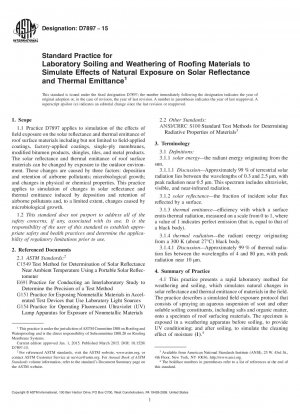ASTM D7897-15
Standard Practice for Laboratory Soiling and Weathering of Roofing Materials to Simulate Effects of Natural Exposure on Solar Reflectance and Thermal Emittance
- Standard No.
- ASTM D7897-15
- Release Date
- 2015
- Published By
- American Society for Testing and Materials (ASTM)
- Status
- Replace By
- ASTM D7897-18
- Latest
- ASTM D7897-18(2023)
- Scope
5.1 The solar reflectance of a building envelope surface affects surface temperature and near-surface ambient air temperature. Surfaces with low solar reflectance absorb a high fraction of the incoming solar energy. Sunlight absorbed by a roof or by other building envelope surfaces can be conducted into the building, increasing cooling load and decreasing heating load in a conditioned building, or raising indoor temperature in an unconditioned building. It can also warm the outside air by convection. Determination of solar reflectance can help designers and consumers choose appropriate materials for their buildings and communities.
5.1.1 The solar reflectance of a new building envelope surface often changes within one to two years through deposition and retention of soot and dust; microbiological growth; exposure to sunlight, precipitation, and dew; and other processes of soiling and weathering. For example, light-colored “cool” envelope surfaces with high initial reflectance can experience substantial reflectance loss as they are covered with dark soiling agents. Current product rating programs require roofing manufacturers to report values of solar reflectance and thermal emittance measured after three years of natural exposure (2, 3). A rapid laboratory process for soiling and weathering that simulates the three-year-aged radiative properties of roof and other building envelope surface materials expedites the development, testing, and introduction to market of such products.
5.2 Thermal emittance describes the efficiency with which a surface exchanges thermal radiation with its environment. High thermal emittance enhances the ability of a surface to stay cool in the sun. The thermal emittance of a bare metal surface is initially low, and often increases as it is soiled or oxidized (4). The thermal emittance of a typical non-metal surface is initially high, and remains high after soiling (5).
5.3 This practice allows measurement of the solar reflectance and thermal emittance of a roofing specimen after the application of the simulated field exposure.
5.4 This practice is intended to be referenced by another standard, such as ANSI/CRRC S100, that specifies practices for specimen selection and methods for radiative measurement.
1.1 Practice D7897 applies to simulation of the effects of field exposure on the solar reflectance and thermal emittance of roof surface materials including but not limited to field-applied coatings, factory-applied coatings, single-ply membranes, modified bitumen products, shingles, tiles, and metal products. The solar reflectance and thermal emittance of roof surface materials can be changed by exposure to the outdoor environment. These changes are caused by three factors: deposition and retention of airborne pollutants; microbiological growth; and changes in physical or chemical properties. This practice applies to simulation of changes in solar reflectance and thermal emittance induced by deposition and retention of......
ASTM D7897-15 Referenced Document
- ASTM C1549 Standard Test Method for Determination of Solar Reflectance Near Ambient Temperature Using a Portable Solar Reflectometer
- ASTM E691 Standard Practice for Conducting an Interlaboratory Study to Determine the Precision of a Test Method
- ASTM G151 Standard Practice for Exposing Nonmetallic Materials in Accelerated Test Devices that Use Laboratory Light Sources
- ASTM G154 Standard Practice for Operating Fluorescent Ultraviolet (UV) Lamp Apparatus for Exposure of Materials
ASTM D7897-15 history
- 1970 ASTM D7897-18(2023) Standard Practice for Laboratory Soiling and Weathering of Roofing Materials to Simulate Effects of Natural Exposure on Solar Reflectance and Thermal Emittance
- 2018 ASTM D7897-18 Standard Practice for Laboratory Soiling and Weathering of Roofing Materials to Simulate Effects of Natural Exposure on Solar Reflectance and Thermal Emittance
- 2015 ASTM D7897-15 Standard Practice for Laboratory Soiling and Weathering of Roofing Materials to Simulate Effects of Natural Exposure on Solar Reflectance and Thermal Emittance

Copyright ©2024 All Rights Reserved